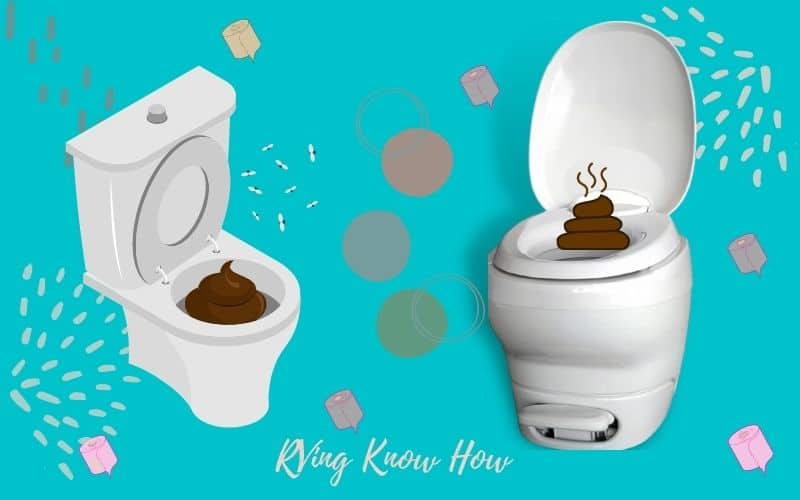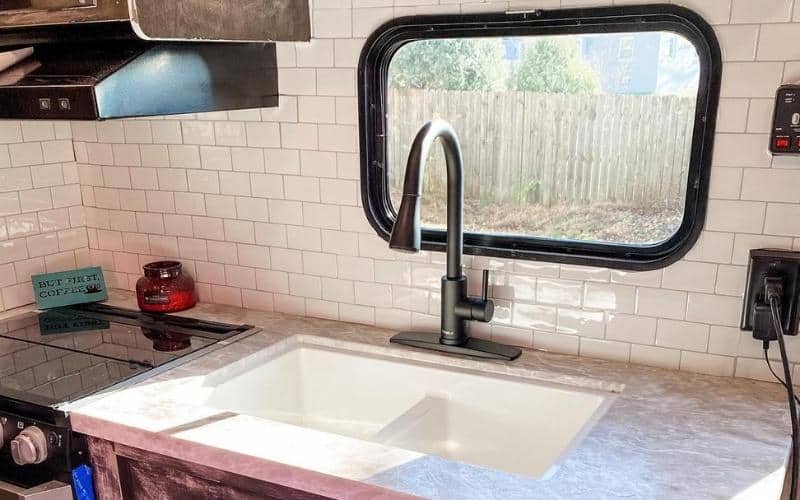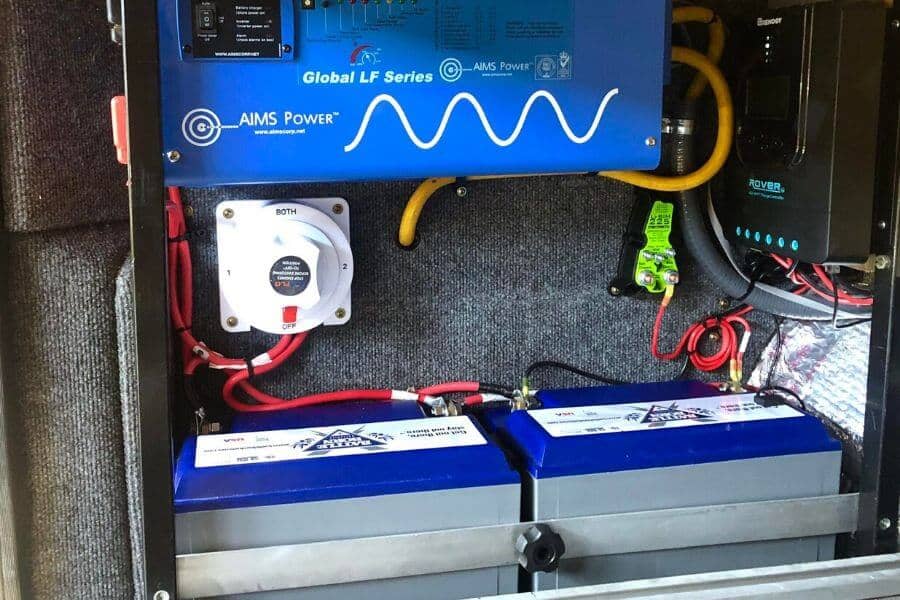When packing the comforts of home into our new houses on wheels, RVer’s are often looking for unique ways to maximize their space and bring splashes of luxury into their recreational vehicles.
Most RVs have carved out a space for a bathroom, some bigger than others.
Specialized RV toilets try to pack the same amenities of a standard toilet into a smaller space, but each model has its drawbacks.
Using the bathroom is something you don’t want to mess around with too much. You already have a winning formula with your household toilet; it may seem like a perfect combination to install your regular house toilet into your RV.
Unfortunately, you cannot replace an RV toilet with a standard household toilet, because amount of water per flush and spatial needs of a standard toilet is not compatible with your RV’s plumbing system.
The two products both fulfill the same need, but that is as far as the similarities go. Everything, from installation, the way you flush the toilet, to how you clean your commode, shifts when you’re using a toilet for an RV.
This article will walk you through RV toilets to understand where the issues arise when trying to replace your RV toilet with a standard throne.
How Do RV Toilets Work?
RV thrones seek to provide the same experience as your bathroom at home, in a very different space. Different RV toilets specialize in delivering various combinations of comfort, portability, and efficiency.
Extra variables come into play when designing a toilet suitable for the road.
Each system optimizes certain convenience areas to fulfill a particular niche within the industry while ensuring a smooth time in the loo.
The right system for your toilet depends on where you plan on using it. RV toilets work towards different strengths, and you’ll have to consider your space, plumbing, and camping goals when choosing your commode.
There are three central RV toilet systems, and here how each system works so you can better understand why you need one in your RV.
1: Gravity Flush
These are as close as it gets to the real deal while in motion. Gravity toilets let the earth do the work for them, built to transport your refuse to a larger holding tank quickly.
Gravity Flush toilets are best for RVers who already have a black water tank system in their RV.
A foot pedal serves as the flushing mechanism to save precious inches. There’s no water-holding tank in the back of the machine, but there is a pumped connection to the fresh water tank.
You also have greater control over the amount of water used per flush to accommodate limited resources.
The least portable out of three RV toilet systems, it serves as a permanent installation in a quieter corner of your camper.
A Gravity Flush toilet is ideal for campers with a well-developed plumbing system and works as close to the one at home as any RV toilet can.
2: Composting Toilet
These toilets first gained notoriety at campgrounds, marinas, and music festivals, but technology increases have allowed companies to craft composting toilets that function in small spaces without leaving a smell.
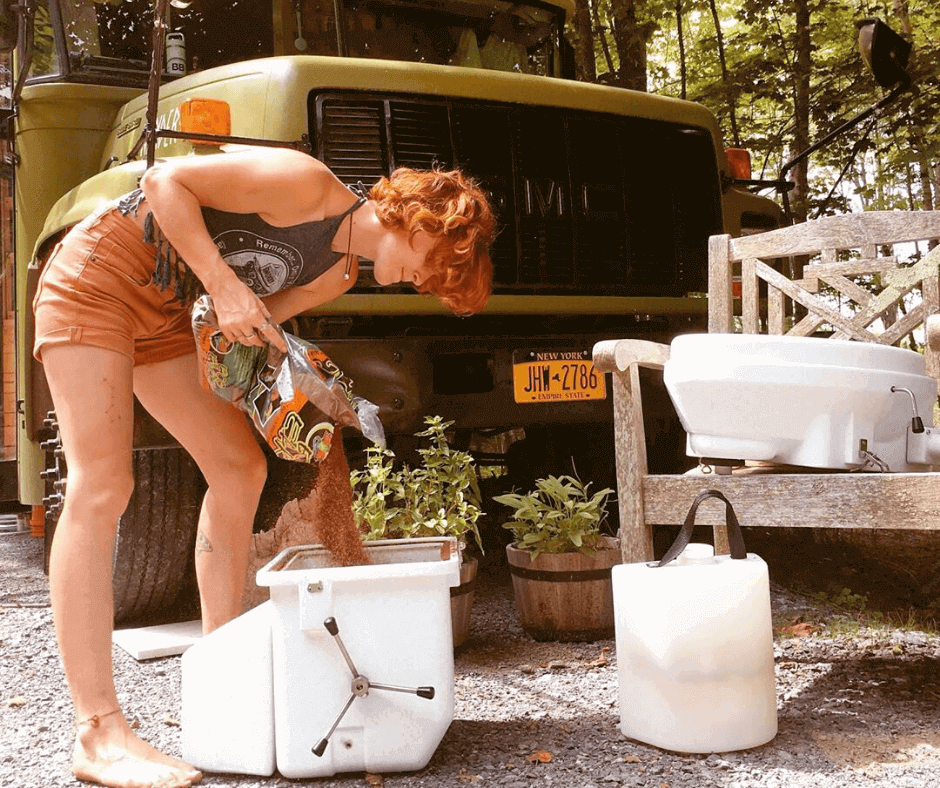
Composting toilet works by using natural bacteria to break down your waste and splitting up your liquids and solids into separate compartments. These benefits allow the smell to stay at a minimum while the materials break down.
Composting toilets are entirely self-contained and don’t need to be connected to a black water tank or RV sewage system to function.
Powerful composting toilets can break down toilet paper as well as excrement. They are ideal for one or two travelers and are frequently seen in smaller Class B RVs.
An entire family may find themselves changing the compost too often for the toilet to be worth an investment, but the solid compartment of a composting toilet can go a month or longer before dumping if there is only one user.
3: Portable Camping Toilet
You don’t always need tons of planning or a permanent installation in your RV.
If you want a simple toilet that can travel wherever you do, a portable camping toilet is just about as far as it gets from your standard bathroom but is better suited to accompany your next drive.
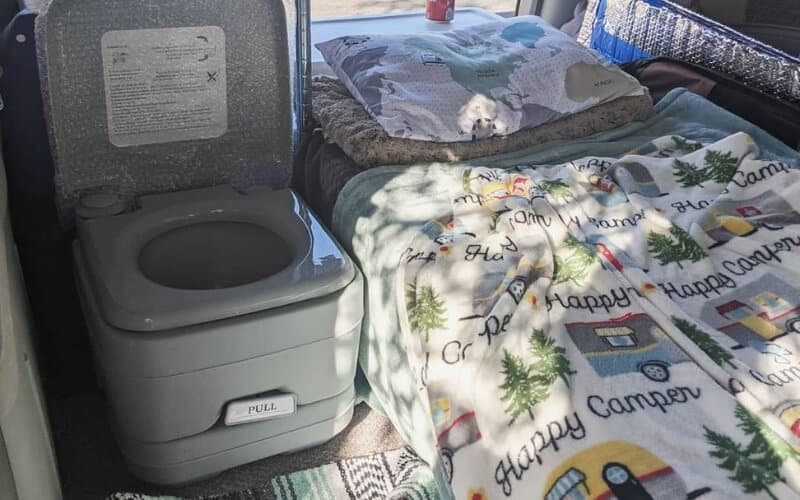
The toilets work the day they are shipped to your doorstep and can quickly move from your vehicle to your campsite once the sun sets.
It’s best suited for very bareboned RV set-ups or emergency scenarios.
These toilets don’t break down your waste as confidently as a composting toilet, and you’ll find yourself dumping the small tanks every few days of use.
A portable camping toilet is not much more than bowl-on-the-go, but campers who aren’t looking for anything fancy find the option gets the job done.
Where RV toilets Differ from Regular House Toilet
Now that you know the different RV toilet models, the reasons why a standard toilet isn’t a suitable replacement may make a bit more sense.
Not one of those options disposes of your waste in the same way as a standard toilet. These are factors that engineers changed from standard toilets when building for mobile use:
Much like a composting toilet, we’ll now break down why so many design differences exist between a household stand and a throne on the go.
1: RV Toilets Buckle Down
Your camper toilet is going to reach the same speeds that you do on your way to your destination.
A simple splashback can turn into a disaster at 70 mph, and regular toilets have heavy parts and tiny pieces that can easily fall apart during a sharp turn.
Standard toilets only use two bolts to hold down the whole system.
RV toilets removed excess water and moving pieces while strengthening measures designed to stay still, keeping everything locked and loaded when on the go.
2: RV Toilets Use Less Water Than Standard Toilets
Every gallon of water you bring with you lowers your RV’s MPG. Most tanks can’t store much more than 40 gallons of fresh water, which can go surprisingly fast if you’re spending a week boondocking.
Standard toilets can consume as much as 5 gallons per flush and can drain your freshwater tank while filling your black water tank at an unsustainable rate.
Even the most excessive RV toilets on the market won’t take up much more than .5 gallons per flush. Composting toilets require none at all!
There’s not much point in a toilet in your RV that requires a trip to a dump station every five uses.
Extra water in your black tank leads to a host of other problems. Standard toilets don’t have the same safeguards against bad smells, and combining liquids with your solids creates the smell we know as sewage.
3: RV Toilets Contain the Waste Once You Flush
Standard toilets at home don’t have to worry about what happens next. Once you flush, the waste exits the bathroom straight to your home’s separate, practically infinite, septic system. Your RV’s toilet won’t have that luxury.
After you use your toilet, you will carry with you every step of the process.
RV toilet’s craftily combated that necessity by wielding space and smell-saving components into their plumbing systems.
Your standard toilet will simply open up a hole and flush straight down into your black water storage tank.
Once your waste is in the tank, it stays in close proximity to your nose, often for days at a time.
Camper toilets safeguard against smell by designing special seals and trap doors that keep your black water tank out of the coach.
3 Reasons Why Installing A Regular Toilet On Your RV Is A Very Bad Idea
Hopefully, the picture is becoming a bit more clear. There is a time and a place for everything, but your RV is not the best place for your house’s toilet.
If you’re not happy about some of the features RV toilets lack, these are some of the reasons why the extra benefits of a regular toilet aren’t always beneficial.
1: Hidden Costs
Using a standard toilet may seem like an excellent way to save a few bucks while putting a high-quality toilet into your RV.
Bathrooms are all about convenience, and especially if you already have an extra toilet at home, it’s worth a shot, right?
The costs aren’t always what they seem at first glance. You’ll likely have to pay to have some parts of your RV’s existing bathroom modified to fit your throne.
Even if you fancy yourself a plumber, you’ll have to switch out a variety of different parts whose prices add up.
2: You’d Better Know A Plumber
New outlets will have to be carved into the walls of your RV to accommodate a standard toilet. You would need a sewer line connection to hook up the toilet to the waste tank.
You’ll then need to make several adjustments to the household toilet operating system to optimize its RV performance.
Finally, you’ll have to engage in some light carpentry to keep everything in place.
You also skip the trial period with this offer. If you switch out your toilet, you’ll have to totally redo the entire process if you ever want to change up your toilet in the future.
3: Hefty Bounty
The commode itself adds a hefty weight to your vehicle. Once you add in the extra weight from the water necessary to fill the toilet and the additional liters your black water tank takes on per flush, you get a much higher overall weight influx.
It won’t be the end of the world for your RV, but you may notice constantly driving around with three full tanks in your MPG.
An RV Toilet is Worth the Investment
Your bathroom isn’t a place for experimentation. Industry leaders have been optimizing RV toilets for decades to come up with the best combination of household luxury and highway efficiency.
Armchair engineers of any mechanical prowess or plumbing ability would still struggle to completely counteract all the disadvantages of taking a hefty home toilet and installing it inside your recreational vehicle.
The lack of barriers between a standard toilet and the sewage system will turn problematic quickly.
Your black water tank will reach its limit much faster than your house’s plumbing system ever could. Blackwater tanks can’t even handle household toilet paper, let alone a standard toilet.
Reduce the number of X-factors when doing your business by combining your RV with the proper toilet.
No toilet design is perfect for the road, but any toilet specifically made to fit in an RV will be a better co-pilot than a standard household toilet.

